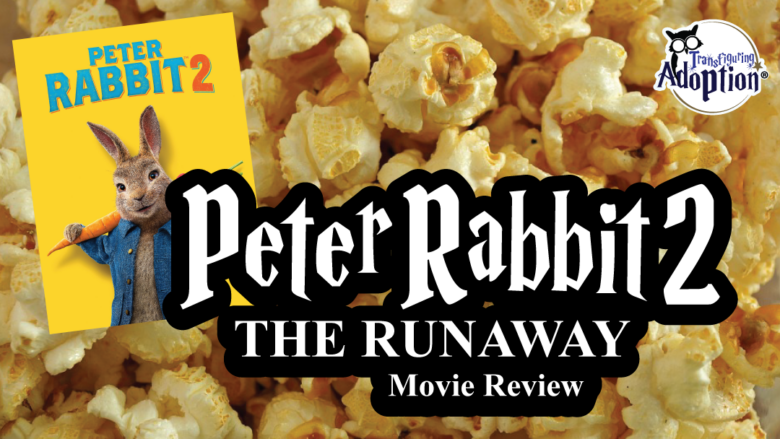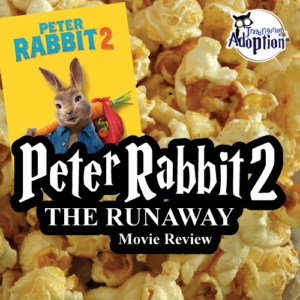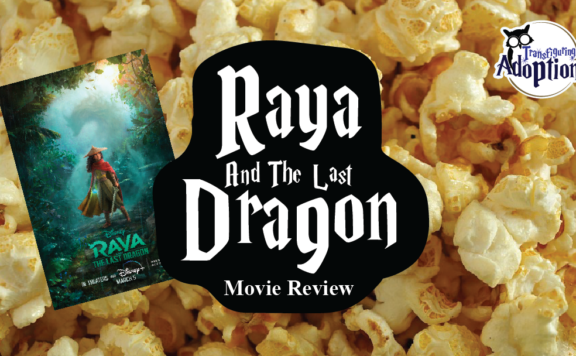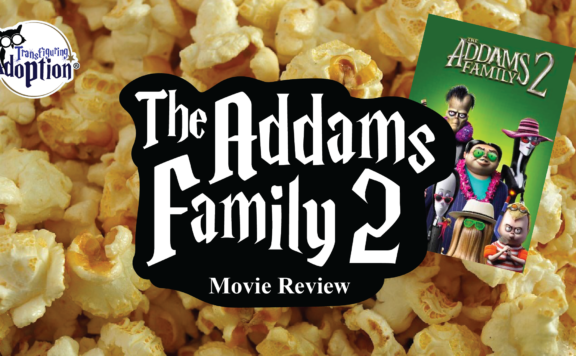Grade:
Transfiguring Adoption awarded this movie 5 Hoots out of 5 based on how useful it will be for a foster/adoptive family. [Learn more about our Hoot grading system here]
Movie Info:
-
Rating: PG
-
Genre: Kids & Family/Comedy
-
Runtime: 93 minutes
-
Studio: Sony Pictures
From the Cover of Peter Rabbit 2: The Runaway by Sony Pictures:
“In PETER RABBIT™ 2: THE RUNAWAY, the lovable rogue is back. Bea, Thomas, and the rabbits have created a makeshift family, but despite his best efforts, Peter can’t seem to shake his mischievous reputation. Venturing out of the garden, Peter finds himself in a world where his mischief is appreciated. However, when his family risks everything to come looking for him, Peter must figure out what kind of bunny he wants to be.“
Transfiguring Adoption’s Overview:
This film is a cute, animated, family comedy. It contains some big lessons and themes interspersed with enough humor to keep it a light-hearted film, which can be enjoyed by the whole family. While it has received just average reviews from the general public, I feel it is a gem for foster and adoptive families. Overall, I found it to be a movie which could inspire some great conversations about past trauma, families, behavior, and big feelings without being incredibly triggering.
** Spoilers Could Be Ahead **
How Is This Relevant To Adoption & Foster Care?
There are several connections to foster care and adoption interwoven throughout this film. The movie opens with Bea and Thomas getting married, and the officiant mentions that Thomas is a new parent, or guardian, to the rabbits. The scene digresses into chaos as Peter yells, “You’re not my father. You’ll never be my father!” and kicks Thomas across the garden. Of course, thankfully, this is all happening in Peter’s head, and in reality, he remains calm and is asked to present the ring.
Three main characters in the movie—Peter, Thomas, and Barnabas—are orphans and discuss the loss of their father figures and related issues throughout the film. Thomas mentions his experiences living in an orphanage. Barnabas monologues about never knowing his dad and no one wanting to adopt him because he “got too old.” Bea essentially became a caregiver to the bunnies when they were orphaned.
Discussion Points:
- How family members support (or don’t support) each other
There are examples in the movie of the family members supporting and not supporting each other. Thomas helps Bea publish her first book and sell it. Bea feels Thomas is not supportive of changes she makes to her second book in order to fit with her new publisher’s ideas. There is conflict over this and discussion about feelings involved. - Acceptance of others
Being accepted by others is an overarching theme of this plot. There are questions of whether different characters, primarily Peter, Flopsy, and Bea, are being someone they are not in order to fit in or be accepted. Peter is struggling with being accepted and understood. He grapples with what kind of bunny he is going to be to fit in. Flopsy decides to change her name, how she walks, and so on in order to be “even more differenter.” Bea changes her artwork and stories to fit the ideas of her new publishing company in order for her stories to be more desirable and sell more. - How others view Peter’s behavior
Throughout the movie, there is discourse about Peter’s behavior, what’s causing it, whether it’s intentional, and whether it can change. Is he simply a “mischief maker,” or is he “a bad seed” or “villain?” Does he make mistakes and have accidents, or does he intentionally misbehave? One (human) child says, “Peter doesn’t have a dad. He got put in a pie. That’s why he’s so naughty.” Bea tells Thomas, “Go easy on him. He’s just getting used to the idea that you’re here to stay.” - Question of whether the animals were stealing
A few times during the movie, the question of whether the animals were stealing from the farmers since they were feeding their families and were there “first” is discussed. I mention below that this could potentially be triggering for children who found themselves or those they lived with needing to steal to get what they needed to survive. It’s not really dwelled on in the film, which could allow for conversation starters without being super triggering. - What makes a family
There is some conflict over whether the bunnies are Bea and Thomas’s family and whether they will be replaced by human babies. At the end of the movie, Thomas states that families come in all shapes and sizes after a comment that he had been afraid Bea’s book would take her away from the family he wanted them to have (referring to human children). He comes to accept his role as a father figure to the bunnies. Barnabas declares that his gang of thieves is a family and states that Peter is now a part of their family, but Peter decides to go back to his farm family and rescue them from the consequences of his mistakes.
- Learning from mistakes
Bea talks about how the bunnies learn from their mistakes. Bea, Thomas, and several members of the family all learn important lessons and work to fix their mistakes. - Having a purpose
Mixed in with the lessons of fitting in and changing to make others happy, is the father rooster being faced with the question of whether he has a purpose. He begins to think that his life is one big lie and says he is questioning his existence. Be sure to watch through the credits because this matter is settled at the end, and he states, “We do matter. We do have a purpose!” - Cultural appropriation
There is a short reference to cultural appropriation when Barnabas and Peter see people dressed like farmers who are not farmers. This comment will likely go unnoticed by many children, but it could be an opener for talking about cultural appropriation, what it is, and how it makes people feel. - Dealing with big feelings
Peter talks about many feelings throughout the movie. He has responses to feeling misunderstood, ganged up on, betrayed or lied to, accepted, stupid, and more. Thomas shares feelings of fear. Barnabas talks about being replaced (rejected). Bea feels unsupported and betrayed. - Trusting others
Trust is portrayed with good and bad examples. Cottontail is very apprehensive (and turns out to be right!) about trusting the publisher, Nigel. Peter quickly trusts Barnabas simply because Barnabas says he was friends with Peter’s dad and ends up being tricked. - How much we share with strangers
Barnabas tells Peter to maybe not “open up so much” to strangers after they have first met and Peter tells him a lot about himself. This is a good opener for discussing who has the rights to our stories and how much we should share with strangers.
Cautionary Points:
- Running themes and discussions based around the loss of fathers or father figures
Three main characters in the movie—Peter, Thomas, and Barnabas—are orphans and discuss the loss of their father figures and related issues throughout the film. Quotes include: “You’re not my father. You’ll never be my father!” “Miss you, Dad. No one gets me the way you did.” “Never knew my dad.” “I lost my father when I was young. So I never really learned how to be one.” - Peter labeled as “naughty,” “a bit of a brat,” or “the bad seed” with others feeling that he cannot change or “is never going to learn”
Peter and others discuss his behavior all throughout the movie. His good behavior is misconstrued and perceived as bad. He often expresses a sense of giving up and giving in to how others view him and resigning to being bad since that’s how he thinks everyone sees him. - Vulnerable individual being lied to and taken advantage of
Barnabas makes Peter feel accepted and cared for in order to use him and the other farm animals to help him and his gang pull a major heist at the farmer’s market. When Peter figures it out, he says, “We just needed sweet, dumb bumpkin bodies” and tells Peter it’s “not hard to lie to someone who wants it to be true.” Often children who have been traumatized are vulnerable and more likely to be victimized. This can be a point of discussion, but it could also be triggering. - Adoption or being an orphan spoken of in a variety of contexts
Adoption is mentioned several times in relation to adopting pets. As animated, human-like characters, children will connect to the animals, and the idea of and discussions of adoption will likely carry over to humans in children’s minds. Barnabas talks about no one wanting to adopt him anymore because he got too old. Thomas asks for the addresses of all the people “who took” the animals from his farm. The pet shop owner states that they prefer to say “adopted.” This could be triggering to children who connect adoption to humans, especially if they feel they were taken from their birth family. - Stealing and ethics of it are discussed
A few times during the movie, the question of whether the animals were stealing from the farmers since they were feeding their families and were there “first” is discussed. This could be a very personal topic to children who experienced themselves or their family members having to steal in order to provide necessities. - Idea that family can stop being family and children can be replaced
Peter says, “We’re their family.” Another animal responds, “Until you’re not,” implying that the rabbits will be replaced by biological children and no longer be family to Bea and Thomas. - Thomas implying that the bunnies are not his children
While the officiant says that Thomas is now a new guardian or parent to the bunnies, Thomas apparently doesn’t share these feelings, at least at the beginning of the movie, as indicated by his comment to Peter: “Honestly, my kids will be so much better behaved!” This may be triggering to foster or adoptive children who do not believe they are viewed as the child of their foster or adoptive parents. - Near violence and characters being tied up
A pig is tied up, and Barnabas tells Peter to “take care of him.” There are a few tense seconds as Peter says that’s not who he is and is pressured by Barnabas to do it if he wants to be part of the gang. This goes on a few statements until Barnabas says it’s a joke. Barnabas’ gang teaches Peter how to make knots, and they are used to tie different characters up a few times.
Discussion Guide:
- When Thomas rolls down the hill, one of the bunnies says, “And that’s why adults shouldn’t do kid stuff.” What are some things you think only kids should do?
Caregiver Note: This is simply a fun question for families to discuss. It can be enjoyable to hear the child’s thoughts and could lead to some fun conversations! - What was in the lunchboxes of the children in the home Peter and Barnabas got taken to? Why does Barnabas say parents put it in there? Do you think that’s true?
Caregiver Note: Again, this is more of an icebreaker type of question. Do parents put vegetables in kids’ lunchboxes just so teachers won’t judge them? What do the kids think? Do parents agree? - What did Peter have in his ears and why? Do you think this is a good way to handle feeling misunderstood or ganged up on? Is this helpful for Peter? Does it help him control himself? Is it useful in his relationships?
Caregiver Note: Benjamin commends Peter for the way he is responding, to which Peter responds by pulling things out of his ears that he says he uses (basically as ear plugs) when he is feeling misunderstood. He then pulls out another version of earplugs that he says he uses when he is feeling ganged up on (because the other bunnies are all “ganging up on” him). These questions can open up to discussions about positive ways to handle feelings.
- Peter deals with some really big feelings in the movie. What feelings did you see him dealing with? What caused him to feel that way? Could you relate to anything Peter said or felt in the movie? What were some ways Peter responded to his feelings that were helpful responses? What were some not so good responses?
Caregiver Note: Again, these questions can open up to discussions about positive and not so positive ways to handle feelings. - When the bunnies meet the publisher, Nigel, and hear his ideas, four of them say “Fantastic!” and Cottontail says, “I don’t trust this guy.” What do you think made her say that? Was she right not to trust him? Can you think of any examples of someone who trusted someone else too easily or quickly in the movie? Why did this character trust so quickly? Was it a good idea? What was the consequence? How do we determine who is safe?
Caregiver Note: Trust is portrayed with good and bad examples. Cottontail is very apprehensive (and turns out to be right!) about trusting the publisher, Nigel. Peter quickly trusts Barnabas simply because Barnabas says he was friends with Peter’s dad and ends up being tricked. This is a good way to introduce the idea that others must earn our trust and that trusting too easily could lead to dangerous consequences. - Barnabas tells Peter to maybe not “open up so much” to strangers. What makes someone trustworthy with our life stories? How do we decide how much of our story someone should know?
Caregiver Note: This is a good opener for discussing who has the rights to our stories and how much we should share with strangers. - Peter says, “Miss you, Dad. No one gets me the way you did.” Is there someone you feel “gets you?” How does this person make you feel that way?
Caregiver Note: We all need to feel like someone else understands us. It is important for us to validate children’s feelings, even if they don’t make sense to us, and help us navigate through their experiences. - Bea says that trying to get the book published took her away from who she really was. How did she change and try to be someone she wasn’t? Who else tried to be someone they weren’t? How did this work out for them?
Caregiver Note: Here we can introduce the concept of not changing who we are in order to be accepted or have others like us… of not compromising our goals or values. - Barnabas tells Peter that it’s “not hard to lie to someone who wants it to be true.” Do you think Barnabas is right? Have you ever really wanted to believe something?
Caregiver Note: People who have been victims are often more vulnerable, others can see this, and this makes them more susceptible to further victimization. This is another angle from which to discuss how others gain our trust. - Benjamin tells Peter, “…you need to think things through and take some advice from those who love you.” What do you think Peter should think through more? What advice should he listen to?
Caregiver Note: Depending on the child, you can personalize this more to their experiences after Peter, but only if you can do so in a non judgmental, safe way. - Peter tells Thomas, “No matter what I do, you always assume the worst.” Do you ever feel this way? How can you handle this feeling in a good way?
Caregiver Note: This is probably something everyone has felt at some point. Try to think of a time you have felt this way and share your experiences in order to connect with your child.
About the Author: Margie Fink
Margie received her degree in psychology and has worked in various social work capacities. Margie has been chosen in the past to speak on Capitol Hill about the Refundable Adoption Tax Credit. She is a witty foster/adoptive mom who is able to give kids from hard places loving structure while providing unbelievable homemade cooking. Margie co-founded Community Kids, a resource and networking 501(c)3 created to assist foster, adoptive, and relative caregiver families.
**Transfiguring Adoption is a nonprofit organization seeking to nurture growth in foster and adoptive families by giving a HOOT about their families. Transfiguring Adoption does not intend for its reviewers nor its review to be professional, medical or legal advice. These reviews and discussion guides are intended to help parents to better be able to connect and understand their children who come from traumatic backgrounds.





